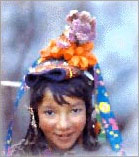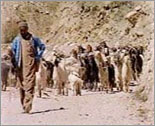
Drass Valley
| Nubra Valley | Indus Valley
| Salt Lake Valley | Shyok Valley
| Suru Valley
Drass
Valley
 Brokpa
Tribe. Their centuries old life style of living in this second coldest
region of Asia with temperatures falling to minus 40 degrees celcius.
Remains cut from the rest of the world for more than 7 months of
a year due to heavy snowfall. A fascinating and enchanting valley
formed by Drass River. Brokpa
Tribe. Their centuries old life style of living in this second coldest
region of Asia with temperatures falling to minus 40 degrees celcius.
Remains cut from the rest of the world for more than 7 months of
a year due to heavy snowfall. A fascinating and enchanting valley
formed by Drass River.
Nubra
Valley
Between China and Pakistan lies the Nubra Valley, a little patch
of Indian land. At the foot of the Karakoram Range, this northern
part of Ladakh is very close to the Siachen glacier. Numerous villages
are scattered in the Nubra Valley.
A few villages
of the Nubra Valley has been opened up thus making it possible for
the adventurous to take a plunge into this fragment of greenery,
nestling between the Karakorams and the Himalayas. Nubra has been
part of the famous old Central Asian trade route known as the "Silk
Road", a Historical Caravan route for traders traveling from
Yarkhand (Central Asia) and Mongolia. Nubra Valley presents features
not seen else where in Himalayan Valleys with its Hot springs at
Panamik. Panamik with its hot water springs is a place of interest
to tourists.
Buddhist
Monasteries have flourished in this region. Diskit Gompa monastery
is over 350 years old containing some old frescos and a statue of
Buddha, it is the oldest and one of the largest in the Nubra region.
Nubra Valley is often referred to as “Orchard of Ladakh”.
Indus
Valley
 This
is a large valley formed by the main channel of the Indus River
as it flows across Ladakh. It includes parts of Leh district, the
Skardu region and the vast cold desert beyond. This valley consists
of large stretches of undulating lands interspersed by high mountains
across which there are many passes. The Indus Valley is the soul
of Ladakh and is strategically the most important part. This
is a large valley formed by the main channel of the Indus River
as it flows across Ladakh. It includes parts of Leh district, the
Skardu region and the vast cold desert beyond. This valley consists
of large stretches of undulating lands interspersed by high mountains
across which there are many passes. The Indus Valley is the soul
of Ladakh and is strategically the most important part.
Salt
Lake Valley
 The
Salt Lake Valley is one of the widest open areas in Rupshu. The
valley has a length of about 20 km and a maximum width of about
7 km. There are two lakes in this valley -- the fresh water Panluk
Lake with an area of about 2 square kilometers and the salt-water
Tsokar Lake with an area of about 10 square kilometers. Deposits
of impure salt occurring on the northern shore of the Tsokar Lake
are collected by the Changpas and used as barter to obtain goods
from other parts of Ladakh. The
Salt Lake Valley is one of the widest open areas in Rupshu. The
valley has a length of about 20 km and a maximum width of about
7 km. There are two lakes in this valley -- the fresh water Panluk
Lake with an area of about 2 square kilometers and the salt-water
Tsokar Lake with an area of about 10 square kilometers. Deposits
of impure salt occurring on the northern shore of the Tsokar Lake
are collected by the Changpas and used as barter to obtain goods
from other parts of Ladakh.
Shyok
Valley
The Shyok Valley is the valley of the Shyok River. This is a Yarkhand
(Central Asian) name and Shyok River also means the river of death.
Probably given by the Central Asian traders who ventured on this
treacherous route for centuries and perished. The entire northern
area -- the region of the Karakoram -- has names related to death.
It is evident that this was a part of the ancient trade route from
Yarkhand (Central Asia) to Ladakh, where many died and only the
hardiest survived. The river freezes in winter, thus forming an
easy access between the Khaplu and the Nubra valleys. The river
freezes in winter, thus forming an easy access between the Khaplu
and the Nubra valleys.
Suru
Valley
 Suru
Valley is relatively more fertile and extends from the Panzella
glacier to south of Kargil town. Suru Valley provides its inhabitants
with an opportunity of harvesting two crops each year. Some of the
vegetables grown here are turnip, radish, peas and black peas. Grapes,
apricots and melons. Suru Valley is inhabited by Baltis whose ancestors
came here from Dardistan and mongoloids from Tibet. Suru
Valley is relatively more fertile and extends from the Panzella
glacier to south of Kargil town. Suru Valley provides its inhabitants
with an opportunity of harvesting two crops each year. Some of the
vegetables grown here are turnip, radish, peas and black peas. Grapes,
apricots and melons. Suru Valley is inhabited by Baltis whose ancestors
came here from Dardistan and mongoloids from Tibet. |


